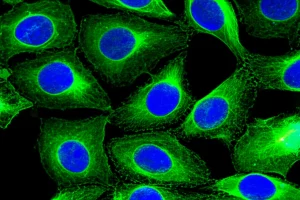Brain’s Tiny Messengers: How EVs Might Spread Trouble in Machado-Joseph Disease
Hey there! Let’s dive into something fascinating happening inside our brains, specifically when things go wrong in a condition called Machado-Joseph Disease (MJD), also known as Spinocerebellar Ataxia Type 3 (SCA3). It’s a tough neurodegenerative disorder where a faulty protein, called mutant ataxin-3, causes all sorts of problems, leading to brain cells dying off. We know this mutant protein misfolds and clumps up, trapping other vital proteins like those involved in the cell’s cleanup crew (autophagy). But what if the trouble doesn’t just stay put? What if it can spread?
That’s where these incredible little things called extracellular vesicles, or EVs, come into the picture. Think of them as tiny bubbles or packages released by cells. They’re like the cell’s postal service, carrying all sorts of cargo – proteins, RNA, you name it – to other cells. Scientists are increasingly realizing that in neurodegenerative diseases, these little messengers might be carrying not-so-good stuff, potentially spreading the disease-associated factors.
Our Quest: Unpacking the EVs in MJD
So, my colleagues and I (well, the researchers whose work I’m telling you about!) got curious. Could EVs from MJD-affected brain cells be involved in spreading the pathology? To figure this out, they used a really clever approach. They took human cells – specifically, induced-pluripotent stem cells (iPSCs) from both healthy individuals (Control, or CNT) and MJD patients. They then turned these iPSCs into neuroepithelial stem cells (NESCs) and further differentiated them into neural cultures, which are like mini-brain environments with neurons and glial cells.
The idea was simple: collect the EVs released by these cells, both from the stem cell stage and the more mature neural culture stage, and see what they’re carrying and what happens when you expose healthy cells to EVs from the MJD cells.
Getting to Know the Tiny Packages
First things first, you have to isolate these EVs and check them out. Using techniques like differential centrifugation and ultracentrifugation, they collected the EVs from the cell culture media. Then, they characterized them using fancy tools like Nanoparticle Tracking Analysis (NTA) and Transmission Electron Microscopy (TEM). What did they find? These EVs were pretty much the size you’d expect – tiny spheres, mostly between 100 and 200 nm. Interestingly, they noticed a *tendency* for the EVs from MJD neural cultures to be a bit less concentrated than those from healthy neural cultures. This might hint at some issues with how MJD cells package and release these vesicles, possibly linked to problems in the endosomal pathway, which is known to be messed up in MJD.
They also confirmed these were indeed EVs by checking for specific protein markers that should be there (like ALIX and Flotillin-1) and making sure markers that shouldn’t be there (like Calnexin, found in the main cell body) were absent. All good on the characterization front!

What’s Inside the Suitcase? Proteins and RNA
Now for the exciting part: what are these EVs carrying? The researchers screened for proteins and mRNA known to be involved in pathways affected in MJD, like autophagy, cell survival, and oxidative stress. They used Western Blot for proteins and RT-PCR/qRT-PCR for mRNA.
They found several key players present in both healthy and MJD EVs:
- p62: An important protein in autophagy, helping to shuttle waste to the cell’s recycling center.
- Beclin-1: Another crucial protein for initiating autophagy.
- SOD1: A protein that helps clean up harmful reactive oxygen species (ROS), dealing with oxidative stress.
But here’s where the MJD EVs started looking different. In EVs from MJD stem cells, they found *lower* levels of p62 and Beclin-1 (a tendency, but still notable) and, strikingly, *higher* levels of SOD1 compared to healthy EVs. In EVs from MJD neural cultures, p62 levels were also significantly *decreased*. This suggests that MJD cells are packaging different amounts of these critical proteins into their EVs.
They also checked for mRNA cargo. They detected mRNA for several autophagy-related genes (SQSTM1, BECN1, UBC, ATG12, LC3B) and the oxidative stress-related gene CYCS in the EVs. However, they didn’t see significant differences in the *levels* of these mRNAs between healthy and MJD EVs. And the disease-causing mutant ataxin-3 mRNA? It wasn’t reliably detected in the EVs, which might just mean it’s there in very small amounts, too low for the methods used.

Do Healthy Cells Pick Up These Packages?
Okay, so EVs are released and carry cargo. But do recipient cells actually take them up? Using a fluorescent dye (CFSE) to label the EVs, they incubated them with healthy human neural cultures. And yes, they saw the green fluorescent dots (the labeled EVs) inside the neurons! This confirms that the EVs are indeed internalized by healthy brain cells. Good to know the postal service is working!
They also checked if exposing cells to these EVs caused immediate toxicity. At the doses tested, neither healthy nor MJD EVs seemed to harm the cell viability over 3 days. So, they might not be immediately killing cells, but perhaps they’re causing more subtle, long-term issues.
The Plot Thickens: MJD EVs Mess with Cell Defenses
This is arguably the most significant finding. The researchers added EVs from MJD and healthy cells to healthy neural cultures and looked at the levels of those key autophagy and oxidative stress proteins after 3 days and 2 weeks.
Here’s what happened when healthy cells got a dose of MJD EVs:
- Levels of several autophagy proteins (LC3B, ATG3, ATG7, Beclin-1, and p62) went *down* after 3 days (though some changes were specific to whether the EVs came from stem cells or differentiated neural cultures). This is a big deal because lower levels of these proteins mean the cell’s ability to perform autophagy – its crucial cleanup and recycling process – is likely impaired. Remember, autophagy is already known to be faulty in MJD!
- SOD1 levels also went *down* after exposure to MJD EVs (seen more clearly after 2 weeks for stem cell EVs and after 3 days for neural culture EVs). This means the healthy cells’ defense against oxidative stress is weakened.
Interestingly, EVs from healthy cells often had the opposite effect, sometimes *increasing* the levels of these proteins, suggesting a potential protective role for healthy EVs. It’s like the healthy postal service delivers tools for maintenance, while the MJD postal service delivers things that break the tools.

Could the Mutant Protein Itself Spread?
Beyond just interfering with cellular pathways, could the problematic mutant ataxin-3 protein itself spread? They set up a clever experiment where healthy neural cells were grown in the bottom of a dish, and MJD neural cells were grown in an insert above them, separated by a membrane. This allowed them to share the culture media (where EVs and other soluble factors float around) but without direct cell-to-cell contact.
After 1, 3, and 8 weeks, they checked the healthy cells for the presence of mutant ataxin-3 aggregates. While they didn’t see a massive amount of large inclusions, they did observe a *tendency* for an increase in smaller ataxin-3-positive spots or aggregates in the nucleus of the healthy cells that had been sharing media with MJD cells, especially over longer periods. This is preliminary, and more studies are needed to confirm it, but it’s certainly suggestive that the mutant protein, or factors that promote its aggregation, might be spreading.

So, What Does It All Mean?
Putting it all together, this research gives us compelling evidence that extracellular vesicles from MJD cells are carrying a different cargo of key proteins (like p62 and SOD1) compared to healthy cells. More importantly, when these MJD EVs are taken up by healthy brain cells, they seem to actively interfere with and *reduce* the levels of proteins essential for cell cleanup (autophagy) and defense against damage (oxidative stress). This could be a significant way the disease pathology is propagated or worsened in the brain.
The finding about the potential spread of ataxin-3 aggregates in the co-culture model, even without direct contact, further supports the idea that MJD isn’t just a problem contained within sick cells; factors released by these cells might be influencing their neighbors.
This work is really important because it highlights EVs as potential players in MJD progression. If EVs are indeed spreading the “bad vibes” in the brain, they could be targets for future therapies. Maybe we could find ways to block the release of problematic EVs, alter their cargo, or even use engineered EVs to deliver therapeutic molecules. They might also serve as biomarkers – perhaps analyzing EVs in bodily fluids could tell us something about the disease state.
Of course, science is a journey, and this is a crucial step. More research is needed to fully understand the mechanisms involved, confirm the protein spreading, and explore the therapeutic potential. But for now, we have exciting new evidence that these tiny brain bubbles, the extracellular vesicles, are definitely involved in the complex picture of Machado-Joseph Disease, potentially acting as messengers of pathology.

Source: Springer







